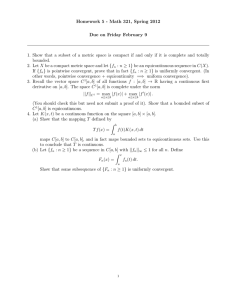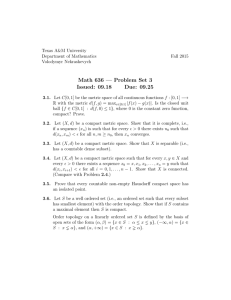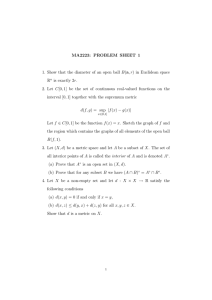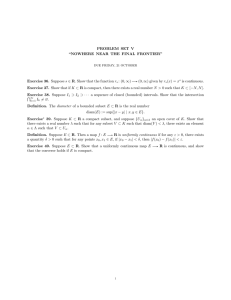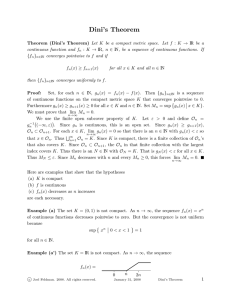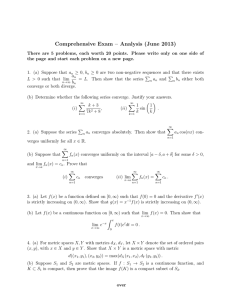Homework 3 – Math 440/508
advertisement
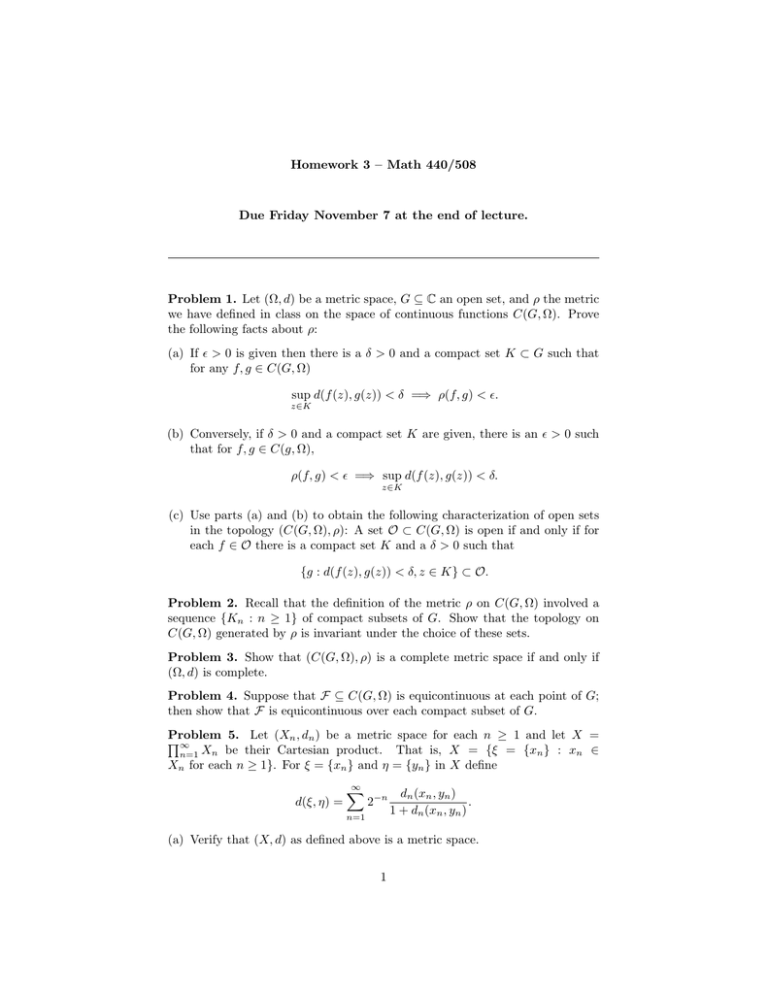
Homework 3 – Math 440/508
Due Friday November 7 at the end of lecture.
Problem 1. Let (Ω, d) be a metric space, G ⊆ C an open set, and ρ the metric
we have defined in class on the space of continuous functions C(G, Ω). Prove
the following facts about ρ:
(a) If > 0 is given then there is a δ > 0 and a compact set K ⊂ G such that
for any f, g ∈ C(G, Ω)
sup d(f (z), g(z)) < δ =⇒ ρ(f, g) < .
z∈K
(b) Conversely, if δ > 0 and a compact set K are given, there is an > 0 such
that for f, g ∈ C(g, Ω),
ρ(f, g) < =⇒ sup d(f (z), g(z)) < δ.
z∈K
(c) Use parts (a) and (b) to obtain the following characterization of open sets
in the topology (C(G, Ω), ρ): A set O ⊂ C(G, Ω) is open if and only if for
each f ∈ O there is a compact set K and a δ > 0 such that
{g : d(f (z), g(z)) < δ, z ∈ K} ⊂ O.
Problem 2. Recall that the definition of the metric ρ on C(G, Ω) involved a
sequence {Kn : n ≥ 1} of compact subsets of G. Show that the topology on
C(G, Ω) generated by ρ is invariant under the choice of these sets.
Problem 3. Show that (C(G, Ω), ρ) is a complete metric space if and only if
(Ω, d) is complete.
Problem 4. Suppose that F ⊆ C(G, Ω) is equicontinuous at each point of G;
then show that F is equicontinuous over each compact subset of G.
Problem 5. Let (Xn , dn ) be a metric space for each n ≥ 1 and let X =
Q
∞
That is, X = {ξ = {xn } : xn ∈
n=1 Xn be their Cartesian product.
Xn for each n ≥ 1}. For ξ = {xn } and η = {yn } in X define
d(ξ, η) =
∞
X
2−n
n=1
dn (xn , yn )
.
1 + dn (xn , yn )
(a) Verify that (X, d) as defined above is a metric space.
1
(b) Show that convergence in the topology of X is equivalent to coordinatewise
convergence.
(c) If (Xn , dn ) is compact for every n ≥ 1, then X is compact.
Problem 6. This exercise shows how the mean square convergence dominates
the uniform convergence of analytic functions. If U is an open subset of C we
use the notation
Z
1
|f (z)|2 dxdy
||f ||L2 (U ) =
2
U
for the mean square norm, and
||f ||L∞ (U ) = sup |f (z)|
z∈U
for the sup norm.
(a) If f is holomorphic in a neighborhood of the disk B(z0 ; r), show that for
any 0 < s < r there exists a constant Cr,s (depending only on r and s but
independent of f or z0 ) such that
||f ||L∞ (B(z0 ;s)) ≤ Cr,s ||f ||L2 (B(z0 ;r)) .
(b) Prove that if {fn } is a Cauchy sequence of holomorphic functions in the
mean square norm || · ||L2 (U ) , then the sequence {fn } converges uniformly
on every compact subset U to a holomorphic function.
Problem 7.
(a) Let X and Ω be metric spaces and suppose that f : X → Ω is one-one and
onto. Show that f is an open map if and only if f is a closed map.
(b) Let P : C → R be defined by P (z) = Re(z). Show that P is an open map
but not closed.
Problem 8. It is easy to see that pointwise convergence of a sequence of continuous functions is in general a weaker condition than convergence of compacta.
However, under certain additional hypotheses, the former implies the latter.
This problem illustrates two such examples.
(a) Consider C(G, R) and suppose that {fn } is a sequence in C(G, R) which is
monotonically increasing (i.e., fn (z) ≤ fn+1 (z) for all z ∈ G) and satisfies
lim fn (z) = f (z)
n→∞
for all z ∈ G where f ∈ C(G, R).
ρ
Show that fn → f . This result is due to Dini.
2
(b) Let {fn } ⊂ C(G, Ω) and suppose that {fn } is equicontinuous. If f ∈
ρ
C(G, Ω) and fn (z) → f (z) for each z then show that fn → f .
P
Problem 9. Let f be analytic on the unit disk with series expansion n≥0 an z n
at 0. Let µ = inf{|f (z)| : |z| = 1}, and suppose that f has at most m zeroes in
B(0; 1). Prove that
µ ≤ |a0 | + · · · + |am |.
Problem 10. Let F ⊆ C(G, C), where G is an open subset of C. If F is
pointwise bounded, i.e.,
sup{|f (z)| : f ∈ F} < ∞
for all z ∈ G,
does this imply that F is locally bounded? Would your answer change if F was
required to be a subset of H(G)?
(Hint : For the second part of the question, argue that it suffices to create a
sequence of analytic functions that converges pointwise to a non-analytic function. Then construct such a sequence of analytic functions (in fact a sequence of
polynomials), taking for granted the following fact: Let K be a compact subset
of the complex plane with connected complement. Let f be a function analytic in
a neighborhood of K. Then there is a sequence of polynomials which converges
to f uniformly on K. Choose a sequence of compact (but not necessarily connected) sets Kn gradually filling up C, and a sequence of functions gn analytic
on an open neighborhood of Kn on which the statement above may be applied.)
3
